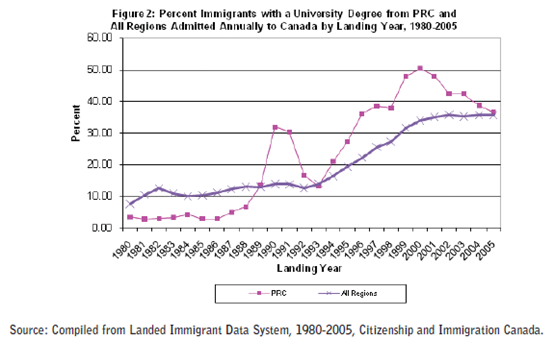Attracting the Best and Brightest
Canada must be more aggressive and proactive if it wants to maintain its envied spot in the global race to attract the best and brightest immigrants, especially from China, India, and other emerging countries, the Globe and Mail editorialized last week. Backed by an in-depth report on Canada’s immigration policy reform, it warned that the competition for talent is heating up as countries like Australia are fast-tracking permanent residence for the best candidates.
“People with options are less and less likely to tolerate hidebound and cumbersome immigration process, waiting as long as 8 years to have their applications processed”, the Globe and Mail opined, noting as well that the Chinese and Indian governments are using tax and visa incentives to draw highly-educated ex-pats back to their homelands. Nonetheless, an extensive world-wide Gallop poll showed that Canada remained the third most popular destination for would-be immigrants, behind the US and the UK.
The newspaper lauded the Tory government for initiating long-overdue reforms such as restructuring the immigrant investor program, providing bonus points for educated applicants with English language proficiency and pre-arranged jobs, expanding the provincial-nominee program, and shifting the responsibility of assessing applicants’ merits from the government to the companies hiring them. The government is also seeking to clear the backlog of applications by closing some 100,000 cases.
But, this isn’t enough, the Globe emphasized. Canadian immigration officers should be actively ‘headhunting’ high-educated and entrepreneurially-minded people with in-demand job skills as well as swinging the doors open to take advantage of global downturns that have lead to unemployment woes in other parts of the world, notably southern Europe. In addition, Ottawa should be doing more to address discrimination in the work place and gate-keeping by professional organizations so that newcomers with foreign credentials and work experience are better able to find suitable jobs.
Currently, Canada accepts about 150,000 economic immigrants (out of a total of 250,000) a year but many experts and politicians would like to see the figure rise dramatically. Should economic immigration double to 300,000, contends the Globe, with other categories remaining constant, total immigration could increase to more than 1% of population or around 400,000. In longer economic terms, over the next decade, with an expected one million job vacancies across Canada and a net negative organic fertility rate, Canada will require even more immigrants. Based on present projections, by 2031, immigration could grow to 500,000 a year, doubling the total today.
A 2010 Canadian International Council (CIC) study on Chinese emigration from the PRC to Canada found that since the mid-1990s Chinese immigrants have been predominately well-educated and in higher proportion than from other source countries. In several years between 1999 and 2005, Chinese immigrants holding a university degree accounted for about 20% of all immigrants with degrees while Chinese immigrants were only 16% of all immigrants admitted.
Looking into the future, and dovetailing with the observations of the Globe, the CIC study sees Canada’s falling fertility rate, the growing importance of a knowledge-based economy, growing dependence on international migration and highly-educated immigration, and the continued generation of a surplus of university graduates in the PRC, as trends that will ensure China as a major source of highly-trained immigrants for Canada.
But, the report also observes that as China’s economy’s grows in breadth and sophistication, many would-be immigrants along with those who have already emigrated, will be attracted back to China in search of better returns for their educational credentials and job skills. (Of the more than 1.92 million Chinese scholars and students who have travelled abroad to deepen their studies and research since the advent of the reform era, roughly 1/3 or 630,000 have returned to the mainland.)
In fact, the reverse brain-drain is gathering momentum. A survey last year on the motivations of Chinese and Indian returnees conducted by Vivek Wadhwa, a researcher at the Harvard Law School and Duke University, found that 90% of Chinese and 60% of Indian returnees named economic opportunities in their countries as a major factor in their decision to return. While majorities in both countries desired to contribute to their country’s economic development, some Chinese respondents said government incentives and preferential policies were important.
Chinese and Indian returnees (53% and 55% respectively) were very optimistic about economic growth prospects in their countries with the Chinese more than Indians considering government support for their fledgling businesses very important. Perhaps surprising to Westerners, 81% of Chinese and 72% of Indians felt that opportunities to start their own businesses were BETTER in their homeland than in the US. Moreover, the speed of professional growth was faster and the quality of life better or at least equal to what they had enjoyed in America.
The CIC report concludes: “the competition for skilled immigrants in the world market is likely to increase as developing countries raise their economic output and reduce the disparity with developed countries and demographic pressures increase in the advanced industrialized world. Under this scenario, countries which can maintain a competitive level of remuneration as well as an enlightened policy of multiculturalism and immigrant integration will be in a better position to attract and to retain skilled immigrants…But, as the shortage of skilled immigrants increases, brain drain may become multi-directional as immigrants well endowed in human capital may be able to circulate in various regions of the world market.”
The global ‘hunt’ for international talent is afoot and Canada must be wise and nimble in sculpting its immigration policies to stay ahead.


